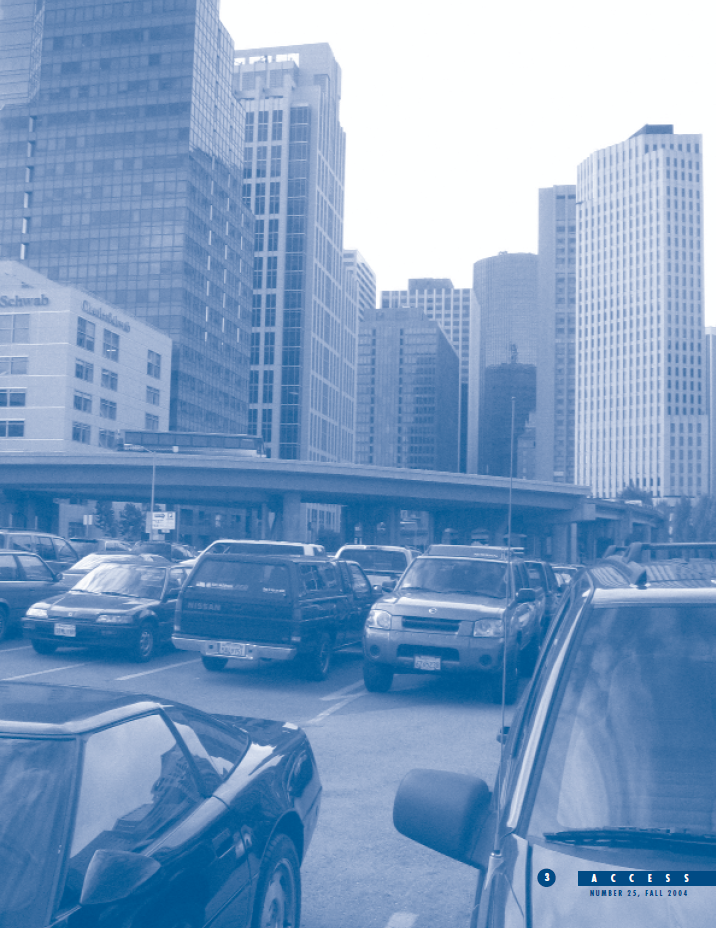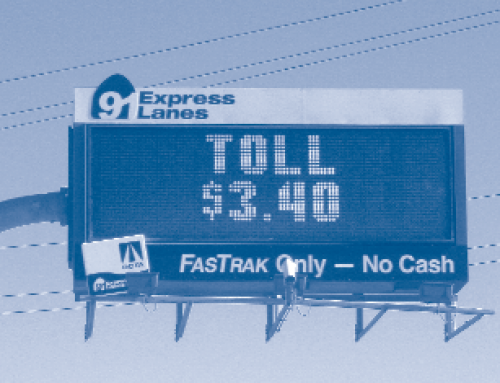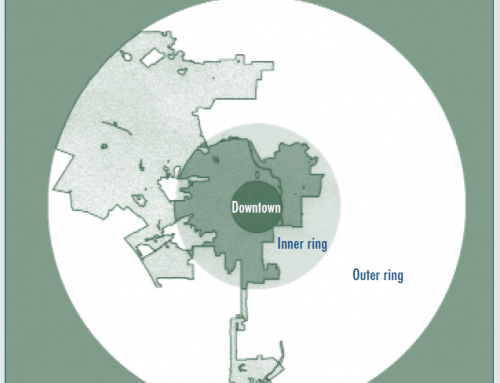 The pop culture image of Los Angeles is an ocean of malls, cars, and exit ramps; of humorless tract homes and isolated individuals whose only solace is aimless driving on endless freeways. From Joan Didion to the Sierra Club, LA has been held up as a poster child of sprawl. This is an arresting and romantic narrative, but also largely untrue.
The pop culture image of Los Angeles is an ocean of malls, cars, and exit ramps; of humorless tract homes and isolated individuals whose only solace is aimless driving on endless freeways. From Joan Didion to the Sierra Club, LA has been held up as a poster child of sprawl. This is an arresting and romantic narrative, but also largely untrue.
To the extent that anyone has a definition of sprawl, it usually revolves around the absence of density, and Los Angeles has since the 1980s been the densest urbanized area in the United States. This would make it the least sprawling city in America. Compared to other US cities, LA also does not have inordinately high rates of automobile ownership.
These facts strike some as hard to believe, or perhaps false, and they haven’t made much of a dent in the LA-as-sprawl idea. Clichés about Los Angeles-style sprawl die hard, partly because the definition of sprawl is so malleable (urbanist William Fulton now simply calls LA “dense sprawl”), and partly because the anti-urban stereotype about LA contains its own kernels of truth. After all, if density is a barometer for healthy urbanism, and Los Angeles is denser than cities like New York or San Francisco, then why are Manhattan and downtown San Francisco such vibrant places, and why is downtown LA comparatively lifeless?
Obviously there’s no single answer to that question (and the question itself is rather prejudicial). But we think the differences between Los Angeles, New York, and San Francisco stem in part from the different ways they regulate downtown development, and in particular the way they regulate parking. Los Angeles is an example of density as a dilemma rather than a solution. Planners and urban critics who regularly call for increased density as a salve for city life should realize that without corresponding changes in parking requirements, increased density will compound, rather than solve, the problems we associate with sprawl.
Density Within Regions And Between Them
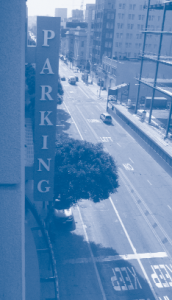 Before opening this discussion, we should make an important distinction. We are referring to the US Census Bureau’s definition of “urbanized areas” rather than to the political boundaries of cities. So when we say that Los Angeles is denser than New York we are actually saying that the Los Angeles urbanized area, which is Los Angeles and its suburbs, is denser than the New York urbanized area, which includes not just New York City but its suburbs as well.
Before opening this discussion, we should make an important distinction. We are referring to the US Census Bureau’s definition of “urbanized areas” rather than to the political boundaries of cities. So when we say that Los Angeles is denser than New York we are actually saying that the Los Angeles urbanized area, which is Los Angeles and its suburbs, is denser than the New York urbanized area, which includes not just New York City but its suburbs as well.
Without doubt, the cities of New York and San Francisco are denser than the city of LA. But sprawl is a regional attribute, and Los Angeles has much denser suburbs than New York or San Francisco. Indeed, the LA region’s distinguishing characteristic may be the uniformity of its density; its suburbs have 82 percent of the density of its central city. In contrast, New York’s suburban density is a mere 12 percent of its central city density, and San Francisco’s suburban density is only 35 percent of the city’s. New York and San Francisco look like Hong Kong surrounded by Phoenix, while Los Angeles looks like Los Angeles surrounded by . . . well, Los Angeles.
In other words, Los Angeles is a dense area without an extremely dense core, while New York and San Francisco are less dense overall but enjoy the benefits of very dense core areas. It’s worth asking why that is. It may be that uniform density across an urbanized area is a result of the inability to have a very dense core. Or it may be that high uniform density precludes having a lively downtown. We don’t have definitive answers to these questions, but we can highlight the tremendous deadening effect that parking regulations have on LA’s Central Business District.
Parking And The Central Business District
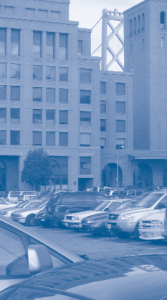 A successful Central Business District (CBD) combines large amounts of labor and capital on a small amount of land. CBDs thrive on high density because the prime advantage they offer over other parts of a metropolitan area is proximity—the immediate availability of a wide variety of activities. The clustering of museums, theaters, restaurants, and offices is the commodity a downtown can offer that other areas cannot. Yet downtowns have long been plagued by questions about access, for they can either thrive on or be destroyed by congestion. In order to thrive, a CBD must receive a critical mass of people every day but do so without clogging itself to the point of paralysis. One way to do this is to require off-street parking spaces. Off-street parking can reduce the cruising for parking that often strangles the streets of CBDs, but parking requirements have high costs.
A successful Central Business District (CBD) combines large amounts of labor and capital on a small amount of land. CBDs thrive on high density because the prime advantage they offer over other parts of a metropolitan area is proximity—the immediate availability of a wide variety of activities. The clustering of museums, theaters, restaurants, and offices is the commodity a downtown can offer that other areas cannot. Yet downtowns have long been plagued by questions about access, for they can either thrive on or be destroyed by congestion. In order to thrive, a CBD must receive a critical mass of people every day but do so without clogging itself to the point of paralysis. One way to do this is to require off-street parking spaces. Off-street parking can reduce the cruising for parking that often strangles the streets of CBDs, but parking requirements have high costs.
It’s not hard to see how a conventional parking lot can undermine a CBD’s success; a downtown surface lot often has a very high and very visible opportunity cost. Instead of a building teeming with activity there is an expanse of asphalt with one employee manning a booth; where there could be something there is instead not much. But even when off-street parking is dressed up or hidden—when it is placed underground, or in a structure that has retail uses at the street level—it is inimical to density. Because land is most expensive in the CBD, off-street parking is also most expensive there, and constructing it uses up capital that could otherwise be invested more productively. More important, if off-street parking is required, as it is in many cities, then it becomes rational for firms to locate in places where land is less expensive, meaning it becomes rational to locate outside the CBD. A parking requirement applied uniformly across a city implicitly discriminates against development in the CBD, because the burden of complying with the requirement is greater in the CBD than almost anywhere else.
A Tale Of Two Parking Requirements
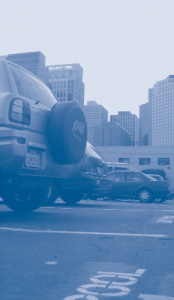 The impact of parking requirements becomes clearer when we compare the parking requirements of our three cities. New York and San Francisco have strict limits on how much parking they allow in their CBDs; Los Angeles, however, pursues a diametrically opposing path—where the other two cities limit off-street parking, LA requires it. This requirement not only discourages development in downtown Los Angeles relative to other parts of the region but also distorts how the downtown functions.
The impact of parking requirements becomes clearer when we compare the parking requirements of our three cities. New York and San Francisco have strict limits on how much parking they allow in their CBDs; Los Angeles, however, pursues a diametrically opposing path—where the other two cities limit off-street parking, LA requires it. This requirement not only discourages development in downtown Los Angeles relative to other parts of the region but also distorts how the downtown functions.
Take, for example, the different treatment given by Los Angeles and San Francisco to their concert halls. For a downtown concert hall, Los Angeles requires, as a minimum, fifty times more parking than San Francisco allows as its maximum. Thus the San Francisco Symphony built its home, Louise Davies Hall, without a parking garage, while Disney Hall, the new home of the Los Angeles Philharmonic, did not open until seven years after its parking garage was built.
Disney Hall’s six-level, 2,188-space underground garage cost $110 million to build (about $50,000 per space). Financially troubled Los Angeles County, which built the garage, went into debt to finance it, expecting that parking revenues would repay the borrowed money. But the garage was completed in 1996, and Disney Hall—which suffered from a budget less grand than its vision—became knotted in delays and didn’t open until late 2003. During the seven years in between, parking revenue fell far short of debt payments (few people park in an underground structure if there is nothing above it) and the county, by that point nearly bankrupt, had to subsidize the garage even as it laid off employees.
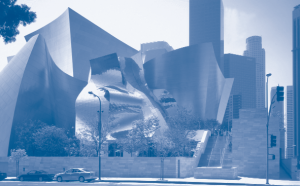 The county owns the land beneath Disney Hall, and its lease for the site specifies that Disney Hall must schedule at least 128 concerts each winter season. Why 128? That’s the minimum number of concerts that will generate the parking revenue necessary to pay the debt service on the garage. And in its first year, Disney Hall scheduled exactly 128 concerts. The parking garage, ostensibly designed to serve the Philharmonic, now has the Philharmonic serving it; the minimum parking requirements have led to a minimum concert requirement.
The county owns the land beneath Disney Hall, and its lease for the site specifies that Disney Hall must schedule at least 128 concerts each winter season. Why 128? That’s the minimum number of concerts that will generate the parking revenue necessary to pay the debt service on the garage. And in its first year, Disney Hall scheduled exactly 128 concerts. The parking garage, ostensibly designed to serve the Philharmonic, now has the Philharmonic serving it; the minimum parking requirements have led to a minimum concert requirement.
The money spent on parking has altered the hall in other ways, too, shifting its design toward drivers and away from pedestrians. The presence of a six-story subterranean garage means most concert patrons arrive from underneath, rather than outside, the hall. The hall’s designers clearly understood this, and so while the hall has a fairly impressive street entrance, its more magisterial gateway is a vertical one: an “escalator cascade” that flows up from the parking structure and ends in the foyer. This has profound implications for street life. A concertgoer can now drive to Disney Hall, park beneath it, ride up into it, see a show, and then reverse the whole process—and never set foot on a sidewalk in downtown LA. The full experience of an iconic Los Angeles building begins and ends in its parking garage, not in the city itself.
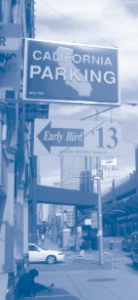 Visitors to downtown San Francisco are unlikely to have such a privatized and encapsulated experience. When a concert or theater performance lets out in San Francisco, people stream onto the sidewalks, strolling past the restaurants, bars, bookstores and flower shops that are open and well-lit. For those who have driven, it is a long walk to their cars, which are probably in a public facility unattached to any specific restaurant or shop. The presence of open shops and people on the street encourages other people to be out as well. People want to be on streets with other people, and they avoid streets that are empty, because empty streets are eerie and menacing. Although the absence of parking requirements does not guarantee a vibrant area, their presence certainly inhibits it. “The more downtown is broken up and interspersed with parking lots and garages,” Jane Jacobs argued in 1961, “the duller and deader it becomes … and there is nothing more repellent than a dead downtown.”
Visitors to downtown San Francisco are unlikely to have such a privatized and encapsulated experience. When a concert or theater performance lets out in San Francisco, people stream onto the sidewalks, strolling past the restaurants, bars, bookstores and flower shops that are open and well-lit. For those who have driven, it is a long walk to their cars, which are probably in a public facility unattached to any specific restaurant or shop. The presence of open shops and people on the street encourages other people to be out as well. People want to be on streets with other people, and they avoid streets that are empty, because empty streets are eerie and menacing. Although the absence of parking requirements does not guarantee a vibrant area, their presence certainly inhibits it. “The more downtown is broken up and interspersed with parking lots and garages,” Jane Jacobs argued in 1961, “the duller and deader it becomes … and there is nothing more repellent than a dead downtown.”
The Density Of Parking
In the end, what sets downtown LA apart from other cities is not its sprawl, or its human density, but its high human density combined with its high parking density. If you took all of the parking spaces in the Los Angeles CBD and spread them horizon- tally in a surface lot, they would cover 81 percent of the CBD’s land area. We call this ratio—of parking area to total land area—the “parking coverage rate,” and it is higher in downtown LA than in any other downtown on earth. In San Francisco, for instance, the coverage rate is 31 percent, and in New York it is only 18 percent.
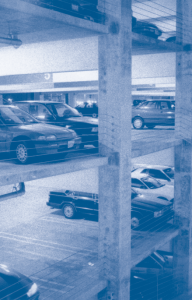 The density of parking depends on both the density of jobs and the number of parking spaces per job. Consider the CBDs of Phoenix, San Francisco, and Los Angeles, which are roughly the same size. Why does Phoenix, which most people would consider the most auto-oriented of the three cities, have the lowest parking coverage rate, at 25 percent? Phoenix has the highest number of parking spaces per job, but also by far the fewest jobs. It has a lot of parking for not many people, and for that reason many commuters to the Phoenix CBD drive alone to work. San Francisco, by contrast, has a lot of people and very little parking—a function of its ordinances that limit parking spaces. This helps explain why many commuters to downtown San Francisco walk, carpool, or ride transit—and contribute to a vibrant CBD by doing so. Although San Francisco has over eight times as many jobs as Phoenix, its parking coverage rate is only slightly higher, at 31 percent.
The density of parking depends on both the density of jobs and the number of parking spaces per job. Consider the CBDs of Phoenix, San Francisco, and Los Angeles, which are roughly the same size. Why does Phoenix, which most people would consider the most auto-oriented of the three cities, have the lowest parking coverage rate, at 25 percent? Phoenix has the highest number of parking spaces per job, but also by far the fewest jobs. It has a lot of parking for not many people, and for that reason many commuters to the Phoenix CBD drive alone to work. San Francisco, by contrast, has a lot of people and very little parking—a function of its ordinances that limit parking spaces. This helps explain why many commuters to downtown San Francisco walk, carpool, or ride transit—and contribute to a vibrant CBD by doing so. Although San Francisco has over eight times as many jobs as Phoenix, its parking coverage rate is only slightly higher, at 31 percent.
And what about Los Angeles? Downtown LA has more than three times as many parking spaces as Phoenix, but it also has five times as many jobs. Compared to San Francisco, LA has fewer jobs but more than twice as many parking spaces. As a result, its parking coverage rate, at 81 percent, is higher than both of the other cities combined. Los Angeles is both car-oriented and dense; it approaches the human density of San Francisco but dilutes it with the parking supply of a suburb. Any benefits Los Angeles might derive from its density are offset by its relentless accommodation of the automobile.
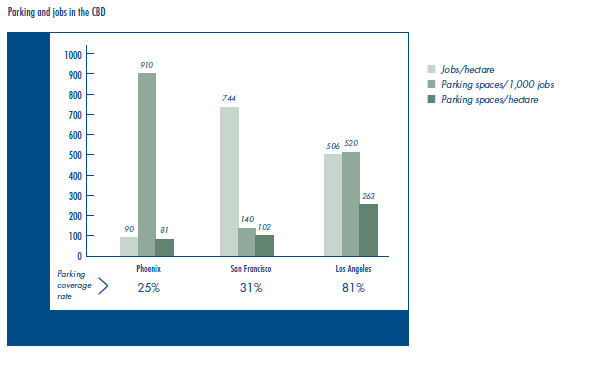 This car-oriented density creates something different from plain old sprawl. Los Angeles is dense and getting denser, but so long as its zoning assumes that almost every new person will also bring a car—and requires parking for that car—it will never develop the sort of vital core we associate with older urban centers. The need to house humans might push toward an increasingly dense center, but the zoning requirement to house cars pushes back, sending development outward. With off-street parking requirements, higher density simply brings more cars and more congestion, as well as increased disruptions in the urban fabric, with money directed away from buildings and toward parking lots.
This car-oriented density creates something different from plain old sprawl. Los Angeles is dense and getting denser, but so long as its zoning assumes that almost every new person will also bring a car—and requires parking for that car—it will never develop the sort of vital core we associate with older urban centers. The need to house humans might push toward an increasingly dense center, but the zoning requirement to house cars pushes back, sending development outward. With off-street parking requirements, higher density simply brings more cars and more congestion, as well as increased disruptions in the urban fabric, with money directed away from buildings and toward parking lots.
Conclusion
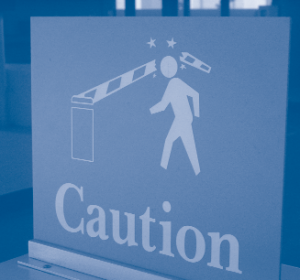 “The right to access every building in the city by private motorcar,” Lewis Mumford wrote in 1961, “in an age when everyone owns such a vehicle, is actually the right to destroy the city.” Mumford meant not physical destruction, of course, but loss of the cohesion that can make a CBD more than the sum of its parts. Parking requirements go a long way toward making downtown LA little more than a group of buildings, each a destination in its own right, to be parked at and departed from, and not part of some larger whole. This missing sense of urbanity—subjective though that term may be—might explain why people often react with disbelief when they are told LA sprawls less than New York or San Francisco.
“The right to access every building in the city by private motorcar,” Lewis Mumford wrote in 1961, “in an age when everyone owns such a vehicle, is actually the right to destroy the city.” Mumford meant not physical destruction, of course, but loss of the cohesion that can make a CBD more than the sum of its parts. Parking requirements go a long way toward making downtown LA little more than a group of buildings, each a destination in its own right, to be parked at and departed from, and not part of some larger whole. This missing sense of urbanity—subjective though that term may be—might explain why people often react with disbelief when they are told LA sprawls less than New York or San Francisco.
So what should we do? We could start by admitting that there is such a thing as too much parking. So long as we continue to make minimum parking requirements a condition of development, we subordinate almost every other function of our cities to the need for free parking. But free parking—indeed, parking in general—is not what makes cities great. It doesn’t create Manhattan and it doesn’t make downtown San Francisco. Urbanists who admire these cities should call for other areas to mimic not simply their density, but also their willingness to limit rather than require parking. Perhaps the simplest and most productive reform of American zoning would be to declare that all existing off-street parking requirements are maximums rather than minimums. From that point we could let the market take care of parking, and let city planners take care of the many vital issues that really demand their attention.
Further Readings
William Fulton and Rolf Pendall. Who Sprawls Most? How Growth Patterns Differ Across the US. (Washington, DC: Brookings Institution) 2001.
Donald Shoup, “Truth in Transportation Planning,” Journal of Transportation and Statistics, vol. 6, no. 1, 2003, pp. 1–16.
Donald Shoup, “The Trouble with Minimum Parking Requirements,” Transportation Research Part A: Policy and Practice, vol. 33A, nos. 7/8, September/November 1999, pp. 549–574.
Donald Shoup, The High Cost of Free Parking, forthcoming from The Planners Press.

